Celestron Ultima 80mm WATERPROOF Spotting Scope 52250 +FREE Celestron TRIPOD
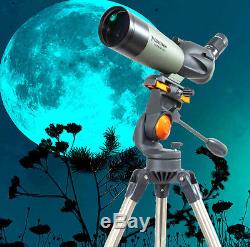
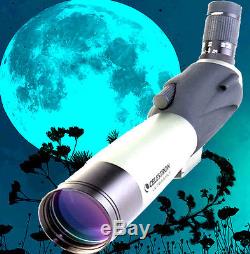
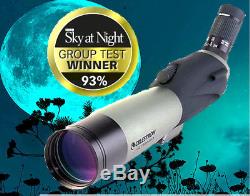
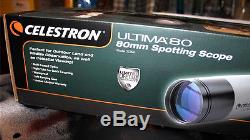
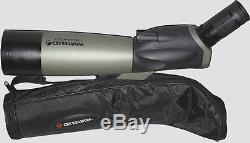
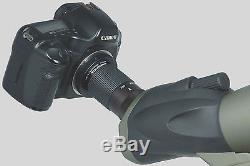
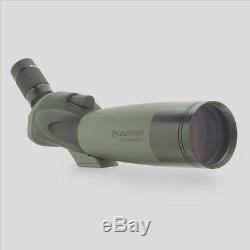

Celestron Ultima 80mm Angled Spotting Scope 52250 with Tripod! Celestron Ultima 80 Angled 45° Degree Spotting Scope Package 52250-OP is a great companion for any nature or outdoor enthusiast. This package consists of the Ultima 80 Angled Spotting Scope 52250 and the Photographic Tripod 93606 from Celestron.
The Celestron Ultima Package comes with everything you will need to get started in observing nature. Celestron Ultima 80mm Spotting Scope 52250 offers a step up in aperture from the 65mm, offering 50% brighter images. The Celestron Ultima 80 mm Refractor features excellent multi-coated optics packed into a portable and durable refractor design. The Celestron Ultima comes standard with a 20-60x zoom eyepiece. You'll love this Celestron Spotting Scope for observing nature and long distance spotting. The green metal optical tube allows for subtle observation in any nature environment. The Photographic/Video Tripod w/ Quick Release 3-Way Head is extremely light and portable, while at the same time, providing a stable and steady platform for a mid-size optical, such as the Ultima 80 Spotting Scope.The tripod features a quick release bracket and pan handle control. It includes a 1/4-20 mounting screw. Its 90° vertical platform has a central column with geared elevator and adjustable tension. There is a convenient and helpful horizontal and vertical bubble level for leveling the scope.
The lock and loose knob is prominently accessible. The tripod extends as high as 63 inches. 20x: 2.0° 60x: 1.0°.
20x: 105' (35 m at 1000 m) 60x: 53' (18 m at 1000 m). 27.0' (8.2 m) at 20x (unspecified otherwise). 20x: 4.0mm 60x: 1.3mm. 18mm at 20x (unspecified otherwise).
20x: 16.0 60x: 1.8. 20x: 40.0 60x: 69.3. 16.0 (406mm) in Length. 3.31 lb (1500 g). Package Contents: Celestron Ultima 80mm Spotting Scope 52250 Objective Lenscap Eyepiece Cap View-Through Case Eyepiece Case Carrying handle and carrying case Celestron Tripod. Mechanical features of this scope.The scopes long focusing knob is located at the top right front of the prism housing to allow precise focusing with either hand, even while wearing gloves or mittens. It is semi-recessed to resist snagging on clothing or carrying case and is grooved for a sure grip. Focusing is quite brisk compared to most scopes, with less than five turns of the focus knob needed to move from one end of the focus range to the other.
The Ultimas 45° viewing angle is generally more comfortable than straight-through viewing for watching treetop activity or for extended observing from a blind or back porch. It is also more convenient for observing couples of varying heights who must share a single scope, as there is little need to constantly raise and lower the tripod to a comfortable observing height for each observer. If you are tall, you will not have to crouch over to see through the Ultima 80, as you would a straight-through scope, saving you from a possible literal pain in the neck. A sighting tube built into the left side of the body allows fast centering of the scope on distant birds. The scope mounts on any photo tripod having a standard 1/4-20 thread mounting bolt. The prism housing is lightly rubber armored to help shock-proof the optics. A water-shedding stay-on soft case is standard equipment. The case has zippered fold-back flaps so you can use the scope on a tripod while it is still in the case. The case has an adjustable length shoulder strap for carrying.A separate zippered soft case (with snap-ring for attaching to a D-ring on the scope case) can hold the eyepiece, if desired. However, the scope case is shaped to fully cover the scope when its angled zoom eyepiece is attached, so you may find the separate eyepiece case to be redundant. A snap-in camera-type lens cover protects the objective lens.
For photography, removing the soft rubber eyecup from the eyepiece exposes standard photographic T-threads. You can attach a 35mm camera body to the scope simply by threading an optional inexpensive T-ring onto the eyepiece and connecting your camera body to the T-ring. No separate camera adapter is needed. The scope becomes a fast 480mm f/6 telephoto lens with a camera attached. A spotting scope is a small telescope that has been modified for use by day.
A spotting scope differs from an astronomical telescope in several important ways. First, a spotting scope always produces an upright image whereas a telescope used in astronomy may produce a reversed image or even an upside down image (not a problem for astronomy).
Second, a spotting scope is much smaller in size than an astronomical telescope, mainly for the sake of portability. Third, a spotting scope is a lower magnification instrument than a telescope, since the atmosphere by day does not allow the high magnifications used in astronomy. Fourth, a spotting scope is mounted on an ordinary photo tripod, but a telescope for astronomy requires a very specialized mount, often unsuitable for daytime use. Lastly, many, if not most, spotting scopes are waterproof and fogproof - a rare feature in an astronomical telescope. Spotting scopes are used anytime you need more magnification than a binocular provides. Spotting scopes are widely used for birding, surveillance, hunting, and viewing landscape, wildlife, ships and other distant objects. Spotting scopes are also used for scoring targets on rifle, pistol and archery ranges and they can also be used to some astronomy. Last, but not least, spotting scopes are also used to take long distance pictures with a variety of cameras.Most spotting scopes are labeled with three numbers. The first two numbers represent the magnification range and the last number is always the size of the front lens. For a 15-45x60 model, then, you have a spotting scope with a zoom magnification range of 15-45x with a front lens of 60mm diameter. Spotting scopes begin in magnification where conventional binoculars stop. The higher magnifications offered by a spotting scope allow you to view birds, wildlife, scenery and other objects that are well beyond the range of a conventional binocular.
However, there are limits to magnification. Two things determine how much magnification you can use in a spotting scope. The first is the atmosphere.
You must always factor in the seeing conditions of the atmosphere when using a spotting scope. Heat waves, dust, humidity, glare, wind and air currents during the day all reduce image quality and the greater the magnification, the more drastic the reduction in image quality. Simply put, there will be days when anything over 30x will appear as mush, but there will also be those clear, calm days when you can use 60x to good advantage.
In general, high altitudes and dry climates favor high magnification whereas wet, humid, low-altitude climates discourage high magnification. Very few locations, however, allow you to use more than 60-80x during the day, so most spotting scopes stop at 60x. The atmosphere, for the same r eason, also limits how much detail you can see at great distances. Seeing tiny detail, such as a person's facial features, at a mile or more through an ocean of turbulent, ever-moving air is simply not possible, no matter how much magnification you use or no matter how large or expensive the instrument.
Spotting scopes are great, but they can't work miracles. On the other hand, it is quite possible to view large objects such as ships at this distance, though the image may be blurry or wavy. The second major limit on magnification is the optical system of the spotting scope, itself.
Regardless of the model, there will always be some drop off in image quality as magnification goes up. This is determined somewhat on the design and size of the scope, but primarily on the quality of the optical system.
Here you get what you pay for in a very visible way. Inexpensive spotting scopes, regardless of size or type, lose image quality quickly as magnification goes up, but premium grade scopes lose very little in image quality, even at the highest magnification. Be prepared to pay, however, if you want a spotting scope that is as sharp at 60x as it is at 20x. Only a handful of very expensive spotting scopes are capable of this. Most observing with a spotting scope, though, is done at lower magnifications, usually around 30x-40x. This is more than enough for most applications and all but the cheapest model will produce reasonable images in this magnification range. Comet Hale-Bopp in 1997 using a 35mm film camera on a tripod. This is a raw image with NO image processing used. Sunrise on the Independence Day by scibuff. The item "Celestron Ultima 80mm WATERPROOF Spotting Scope 52250 +FREE Celestron TRIPOD" is in sale since Friday, August 22, 2014.This item is in the category "Sporting Goods\Hunting\Scopes, Optics & Lasers\Spotting Scopes". The seller is "bluequasar17" and is located in Pewaukee, Wisconsin. This item can be shipped worldwide.
- Type: Spotting Scope
- Max Magnification: 60x
- Use: Bird Watching
- Features: Image Stability
- Brand: Celestron
- Model: Ultima 80
- MPN: 52251
- Body Type: Angled
- Coating: Multi-Coated
- Eyepiece Type: Zoom Eyepiece
- Waterproof: Without Waterproof

